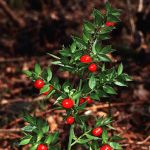| Common Name: |
Jew's Myrtle |
| Other Names: |
Butcher's Broom, Box Holly, Knee Holly, Sweet Broom |
| Botanical Name: |
Ruscus aculeatus |
| Genus: |
Ruscus |
| Family: |
Ruscaceae |
| Native Location: |
Europe, N Turkey, N Africa, and the Azores. |
| Cultivation: |
Well-drained to dry soil in sun or shade. Remove dead shoots in spring. For fruiting, plant hermaphrodite specimens, or set male and female plants in groups of several females to each male. |
| Propagation: |
By seed sown in autumn; by division in spring or autumn. Seeds may take 18 months to germinate. |
| Harvest: |
Plants are cut in late spring, and roots lifted in autumn, and dried for use in decoctions, ointments, and suppositories. Young shoots are gathered in spring for culinary use. |
| Height: |
75cm-1.2m (2½-4ft) |
| Width: |
1m (3ft) |
| Hardiness: |
Z7-9 |
| History: |
Ever since the first century CE when Greek physician Dioscorides touted butcher's broom as a remedy for kidney stones, practitioners of folk medicine have use this decorative Mediterranean plant—often used in Christmas garlands and bouquets—to treat bladder, kidney, liver, and urinary tract ailments. Popular among Europeans, and especially among Greeks (who brought the plant to America), butcher's broom has been a favorite healing herb of people whose work involves standing all day. Chemicals in the plant swiftly constrict veins and reduce swelling in the ankles, calves, and limbs. The plant's unusual branches, which end in sturdy, leaflike stalks, were tied together and used to clean butcher's blocks—hence the herb's unusual common name. |
| Parts Used: |
Whole plant, young shoots, roots, leaf, rhizomes |
| Properties: |
An aromatic, diuretic, mildly laxative herb that reduces inflammation, increases perspiration, and constricts the veins. |
| Medicinal Uses: |
Internally for jaundice, gout, kidney and bladder stones; also for venous insufficiency and hemorrhoids. Externally for hemorrhoids.
To treat hemorrhoids, and pain and other symptoms of poor circulation in the legs. Germany's Commission E has approved the use of butcher's broom to treat hemorrhoids and vein ailments.
Butcher's broom has anti-inflammatory, diuretic, laxative and sweat-promoting properties. It also constricts the veins. Butcher's broom is taken internally for carpal tunnel syndrome, edema (water retention), hemorrhoids, obesity, phlebitis (inflammation of the veins), poor circulation in hands and feet, thrombophlebitis (inflammation of the veins with blood clot), and varicose veins (dilated and swollen veins). It is applied externally, in creams, for chilblains (swelling in the hand and feet due to exposure to the cold), hemorrhoids, and varicose veins. |
| Preparation: |
Butcher's broom is available as dried herb and in capsules, creams, teas, and tinctures. To make a tea, pour 1 cup of boiling water over 1 teaspoon of dried herb and steep for 5 minutes. Strain, and drink up to 2 cups a day. |
| Caution: |
Do not take butcher's broom if you have high blood pressure (hypertension), or if you are taking medication for hypertension. |
| Possible Side Effects: |
Loss of appetite, nausea, vomiting |
| Drug Interactions: |
| Taking butcher's broom with this drug may interfere with the actions of the drug: |
| Prazosin, (Minipress, Nu-Prazo) |
| Taking butcher's broom with these drugs may increase the risk of a hypertensive crisis (a rapid and severe increase in blood pressure that can trigger a heart attack, stroke, and other problems): |
| Iproniazid, (Marsilid) |
Moclobemide, (Alti-Moclobemide, Nu-Moclobemide) |
| Phenelzine, (Nardil) |
Selegiline, (Eldepryl) |
| Tranylcypromine, (Parnate) |
|
| Supplement Interactions: |
- May have additive effects when combined with herbs with alpha-agonist properties.
- May decrease the effects of herbs with alpha-antagonist properties.
|
| Culinary Uses: |
Young shoots are eaten like asparagus.. |
| Warning: |
Contraindicated for hypertension |
| Bibliography: |
Encyclopedia of Herbs by Deni Brown Copyright © 1995, 2001 Dorling Kindersley Limited Pg 352
The Essential Herb-Drug-Vitamin Interaction Guide by Geo. T. Grossberg,MD and Barry Fox,PhD Copyright©2007 Barry Fox,PhD. Pp. 104-105
The Modern Herbal Primer by Nancy Burke Copyright©2000 Yankee Publishing, Inc. pp. 112-113 |

